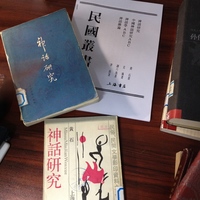
Yongxian QU
Eco-anthropologie, epics studies, Tai (Dai) ethnic group in China, Tai singer Zhangkhap, Tai epics, folklore, Theravada Buddhism.
Supervisors: Nicole REVEL
Supervisors: Nicole REVEL
less
Related Authors
LI ZHIYING
Sichuan University
xu chaoran
EPHE
tfff err
Aston University
LUMengya卢 梦雅
Shandong University, China
Rui Zhou
Southwest University
Jiayan Mi
The College of New Jersey
Feng Yu
University of Toronto
li jing
Tibet University
Xiwang KE
Xian Jiaotong University
InterestsView All (12)






Uploads
Papers by Yongxian QU
The Narrative of ALuang consists of hundreds of stories and represents a significant component of the epic tradition of the Dai people in China. "ALuang" does not refer to a specific individual but is a general term for the 550 incarnations of the Buddha before attaining enlightenment. These incarnations can be categorized into three types: the ALuang as animals or plants, the ALuang as semi-human and semi-divine beings, and the ALuang as humans, reflecting a progressive evolution.
Although the specific content of each ALuang narrative varies, they share numerous similar motifs that form a logical motif chain. Moreover, an analysis of three ALuang stories reveals a highly consistent narrative structure. From the perspectives of ALuang's identity types, motif chains, and narrative structure, it becomes evident that the ALuang narratives share commonalities with the heroic narrative traditions of other cultures worldwide.
Keywords: One Hundred Epics Project; Creation Epic; Dai Epic; Zhangkhap; Intangible Cultural Heritage in Video Form.
传统上傣族创世史诗与祭祀寨神勐神和寨心石等仪式紧密结合,但是这些仪式活动通常受限在特定的时间和空间中,且具有一定的排外性。“中国史诗百部工程”子课题“傣族世史诗·《捧尚罗》”在西双版纳录制视频,原计划获得史诗学意义上的“仪式中的演述”资料,但基于具体情况只能做出相应的调整,改为“录音棚”式的演唱视频。此外,也录制了一个完整的上新房仪式及仪式中的章哈演唱,作为史诗演述与传承的背景资料。在完成课题的过程中了解到傣族史诗的独特传统以及章哈仪式演唱的法则与禁忌,也了解到以影像方式记录的史诗文本与纸质版的史诗文本必定相去甚远。随着社会的发展,创世史诗日益与仪式语境相脱离,好在有职业歌手章哈,这使得傣族创世史诗可以脱离语境转向世俗化发展和传承。
关键词:史诗百部工程;创世史诗;傣族史诗;章哈;非遗影像
关键词:谷种起源;谷魂崇拜;史诗;口头传统;南传佛教
s the inheritance of the Pattra leaf culture in the Dai ethnic areas of Xishuangbanna. First, Man la in Men gz he town is the representative of m
any natural villages of Dai ethnic group.It has made remarkable achievements through bold reform and innovation in the construction of“new socialist countryside"and"beautiful countryside", and is a successful model for the revitalization of rural culture in Dai ethnic areas.Second, the olive dam Dai garden in Menghan town has better protection and inheritance of both material and non-material culture in the mode of "ecological culture museum". Third,promoting the“traditional culture into the campus"in Xishuangbanna primary and secondary schools can accurately position the youth population in a specific space, and strive to achieve the intergenerational inheritance of ethnic culture.These diversified models are playing different roles, which are the efforts of the Dai people to protect,inherit and innovate the excellent Pattra-leaf culture.
The Narrative of ALuang consists of hundreds of stories and represents a significant component of the epic tradition of the Dai people in China. "ALuang" does not refer to a specific individual but is a general term for the 550 incarnations of the Buddha before attaining enlightenment. These incarnations can be categorized into three types: the ALuang as animals or plants, the ALuang as semi-human and semi-divine beings, and the ALuang as humans, reflecting a progressive evolution.
Although the specific content of each ALuang narrative varies, they share numerous similar motifs that form a logical motif chain. Moreover, an analysis of three ALuang stories reveals a highly consistent narrative structure. From the perspectives of ALuang's identity types, motif chains, and narrative structure, it becomes evident that the ALuang narratives share commonalities with the heroic narrative traditions of other cultures worldwide.
Keywords: One Hundred Epics Project; Creation Epic; Dai Epic; Zhangkhap; Intangible Cultural Heritage in Video Form.
传统上傣族创世史诗与祭祀寨神勐神和寨心石等仪式紧密结合,但是这些仪式活动通常受限在特定的时间和空间中,且具有一定的排外性。“中国史诗百部工程”子课题“傣族世史诗·《捧尚罗》”在西双版纳录制视频,原计划获得史诗学意义上的“仪式中的演述”资料,但基于具体情况只能做出相应的调整,改为“录音棚”式的演唱视频。此外,也录制了一个完整的上新房仪式及仪式中的章哈演唱,作为史诗演述与传承的背景资料。在完成课题的过程中了解到傣族史诗的独特传统以及章哈仪式演唱的法则与禁忌,也了解到以影像方式记录的史诗文本与纸质版的史诗文本必定相去甚远。随着社会的发展,创世史诗日益与仪式语境相脱离,好在有职业歌手章哈,这使得傣族创世史诗可以脱离语境转向世俗化发展和传承。
关键词:史诗百部工程;创世史诗;傣族史诗;章哈;非遗影像
关键词:谷种起源;谷魂崇拜;史诗;口头传统;南传佛教
s the inheritance of the Pattra leaf culture in the Dai ethnic areas of Xishuangbanna. First, Man la in Men gz he town is the representative of m
any natural villages of Dai ethnic group.It has made remarkable achievements through bold reform and innovation in the construction of“new socialist countryside"and"beautiful countryside", and is a successful model for the revitalization of rural culture in Dai ethnic areas.Second, the olive dam Dai garden in Menghan town has better protection and inheritance of both material and non-material culture in the mode of "ecological culture museum". Third,promoting the“traditional culture into the campus"in Xishuangbanna primary and secondary schools can accurately position the youth population in a specific space, and strive to achieve the intergenerational inheritance of ethnic culture.These diversified models are playing different roles, which are the efforts of the Dai people to protect,inherit and innovate the excellent Pattra-leaf culture.